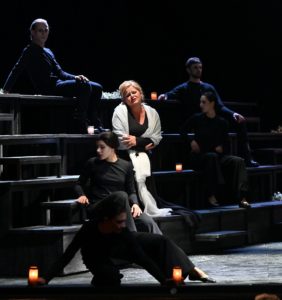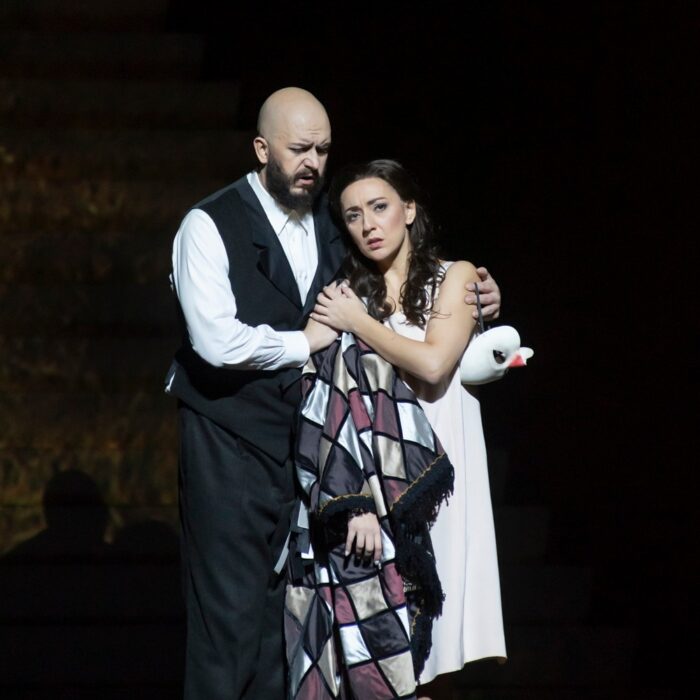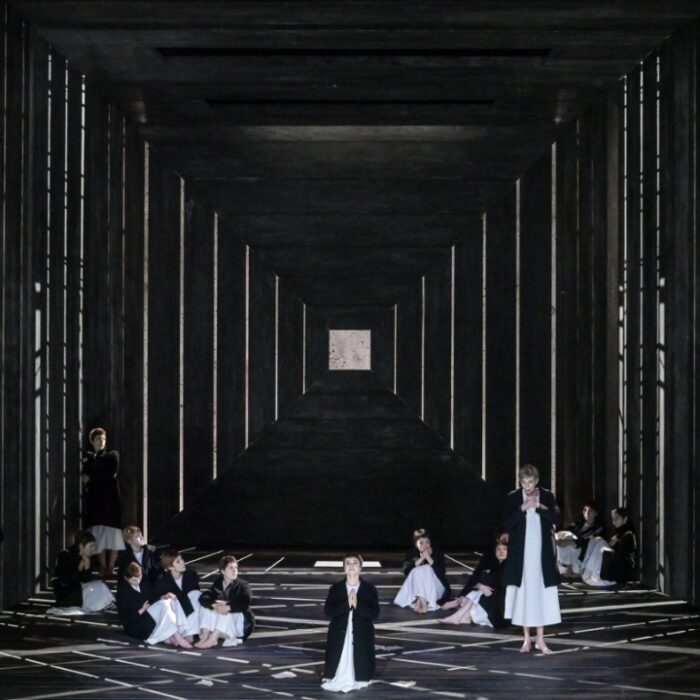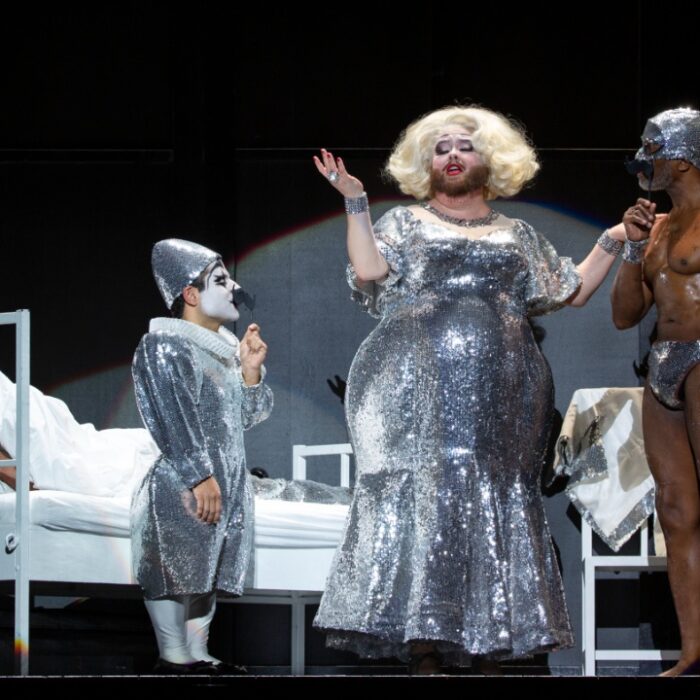
Festival Verdi 2022 Review: Il Trovatore
An Intimate Performance with Surprising Lead Turns by Marigona Qerkezi & Simon Mechlinski
By Francisco SalazarOn Oct. 13 the final performance of the Festival Verdi 2022’s “Il Trovatore” took place at the Teatro Girolamo Magnani di Fidenza.
The theater is small and intimate with a capacity of 430 seats, creating a special operatic experience. “Il Trovatore,” one of Verdi’s most famous and most performed works, is an opera notorious for its often-confusing plot and vocal demands of its central quartet.
Blackbox Theater
Given how difficult the work is to comprehend for some (that does not include me), one would expect that a staging of Trovatore would be made to become more comprehensible and enjoyable to watch.
However, in the hands of Elisabetta Courir with sets by Marco Rossi, the evening was quite difficult to watch. The sets were essentially a black-box theater with bleachers that made the sets feel small and lacking in depth. The costumes were also all black melding into the space and furthering the depth problem.
In the end, it almost seemed like it would have been better to do an opera in concert, as the entire evening was filled with static tableauxs that added nothing new to the story.
And when Courir wanted to add a new element it only added confusion. For the character of Leonora, a separate actress portrayed the character as soprano Marigona Qerkezi sang the role. The blocking of the actress was a distraction because Leonora was the only character represented in this way and the explanation was never really ever revealed. It also didn’t help that Qerkezi is such a magnetic performer that made you want to focus solely on her. This limited the effectiveness of numerous interactions. For instance, the duet between the Count and Leonora would have been all the more captivating between Simon Mechlinski and Qerkezi instead of between the actress and the baritone. In the end, this element of the story was a distraction that hurt the overall emotional experience.
That said, there was one moment in the evening when the production actually created a haunting setting and it was during the “Miserere.” During the scene, a number of supernumeraries came on stage walking with candles. The lighting effect was brilliant and suitable for the dark shades of the music.
Surprising Up & Comers
And now we get to the singers.
In the role of Leonora, Marigona Qerkezi sang a striking Leonora, and announcing herself as a soprano to look out for. Qerkezi has a plush soprano with a roundness from the top to the lower parts of the voice. The moment she entered the stage you knew this was a commanding presence and she didn’t disappoint. Her opening “Tacea la Notte Placida” showcased Qerkezi’s gorgeous legato line that flowed from one note into the next. The only moments where she cut the line was is in the phrases “Infino allor sì muto” and “Egli era! egli era desso!…” where instead of doing the traditional portamenti, she opted for the original markings of the score; in a way that space gave it a haunting feel. Qerkezi also opted for the original cadenza that goes up to the high C; while she did not sustain it, it showed the soprano’s flexibility in reaching the highest notes in her voice. That flexibility was furthered in the cabaletta “Di tale amor” as the sound brightened and florid lines were articulated with such ease and precision that one could really feel Leonora’s joy.
That easily changed in the second half of the opera in Leonora’s big triple aria and ensuing duet. The “D’amor sull’ali rosee” was a true lament as she spun the notes with extended legato lines. The sound had a somber timbre that expressed the pain of her Leonora and one felt as if Qerkezi didn’t want the aria to end. It was entrancing to see her expressive face move with the music. Then in the “Miserere d’un alma gia vicina” the voice turned even darker and lower tones, while not always resonant, obtained a natural weight that showed Leonora in desperation mode. As she repeated the “Di te, di te scordarmi!!…” the soprano’s voice garnered more volume and she sang with greater force. That ended in a beautiful crescendo that continued into “Tu vedrai che amore in terra” without a pause. Here Qerkezi regained strength and determination in the voice. The coloratura was sung to perfection and as she repeated it the voice continued to gain strength, never running out of air. On the second repeat, Qerkezi gave a ritardando to the lines “O con te per sempre unita” almost as if her character had second thoughts. But she eventually went back to the rapid tempo ending that portrayed a Leonora with determination.
The ensuing duet “Udiste? come albeggi” was captivating as Qerkezi sang the coloratura lines pleaing to Simon Mechlinski’s Count and the two voices melded so perfectly. While Mechlinski’s voice was authoritative and without sympathy, hers was filled with anguish. While the baritone sang with staccato phrasing, Qerkezi’s line was a fluid line that rose to the higher reaches with ease. The “Vivrà!… contende il giubilo” saw the soprano’s voice turn to a mix of joy and nostalgia as Mechlinski’s baritone took on a jovial sound as he sang the text “Fra te che parli?… volgimi.” This was one of the highlights of the evening as both voices were well suited for each other. It was just unfortunate that Qerkezi never interacted with Mechlinski because of the staging because if they would have interacted together it most likely would have been even more dramatic than it already was.
As noted Simon Mechlinski performed the role of the Count de Luna and, just like with the duet, he was captivating throughout the evening. The moment he entered singing his “Tacea la notte” his voice was filled with elegance and beauty. These lines were sung with a melting expression. But in the trio that all changed and his voice gained strength and his breath control was striking as he sang the patterlike staccato phrasing with ease and with such increíble enunciation and diction. Here his tone boomed with anger and force. This was just a warmup for the aria to come.
His “Il balen del suo sorriso” was a masterclass in breath control and sustaining lines. From the moment he started the aria, the voice was ardent with expression. His Count was romantic in every way and for these four minutes, one forgot that he was the villain of the opera. His melting baritone could go from a gorgeous mezzopiano to a passionate forte and each note was impeccably connected. Then after the passion of the aria came the cabaletta “Per me ora fatale.” Here the smoldering ardor was back but coupled with strength and drive. Each time he would push the tempo forward to emphasize his power. And what was so impressive about Mechlinski, like Qerkezi, was that on the repeat of the cabaletta, his breath control got better and his vocal quality gained strength.
In the second part, during the “In braccio al mio rival,” the baritone sang with a sardonic tone that brought out the villainous quality of the character and showed his power over Azucena. But in their next interaction at the end of the opera, his final lines “E vivo ancor!” the bartone sang with remorse and madness. It was by far one of the best Count interpretations I have seen.
Uneven But Striking
Angelo Villari performed the title role with an ardent voice that was filled with passion. His voice has a booming sound that can fill the space with facility. His entrance serenade was sung with a fluid line that showcased a flexible legato. But it was sung with the same brassy sound that he would use in the ensuing trio that displayed strength of his Manrico.
In his duet with Rosanna Rinaldi, Villari once again displayed a searing timbre that gave his Manrico a heroic pull. However, his weighty tone betrayed him in “Ah! si ben mio” as Villari was unable to sustain a pure mezzo piano or piano sound. While he tried to phrase it with elegance, the sound turned choppy and the lines were cut short, making for an unpleasant presentation of the aria. Only in the phrase “Fra quegli estremi aneliti, A te il pensier verrà,” when Villari opted for a piano sound, was he able to create a fluid and free-flowing line. But the moment he was forced to crescendo, the line was once again uneven.
On the other hand, the “Di Quella Pira” was quite virtuosic and perfect for the trunpet-like voice. Here Villari demonstrated a heroic sound that seemed to grow with power. In his repetition, he extended a couple of lines and the higher tessitura gleamed throughout the auditorium. It seemed like he had infinite breath support as he sang every line that Verdi wrote and while there was no final High C, Villari made sure to hold the final “corro a morir!” The sound traveled with such ease and strength and he deservedly garnered a healthy applause. In the final act, Villari used his enormous sound to his benefit as he sang the line “Ha quest’infame l’amor venduto…Venduto un core che mi giurò!” with desperation and quickly turned them into a lament. The choppiness of his phrases were effective as they created Manrico’s suffering through his expressive voice.
In the role of Azucena Rosasna Rinaldi gives it her all, committing herself to the character in what became the most dynamic characterization in the first half. One could see her search for vengeance but also the suffering and pain that has led her to madness. And that captivating stage presence is so convincing one can almost forgive her vocal deficiencies.
Rinaldi has a rich middle voice that is well-suited for the “Strida la Vampa” which she sang with assertion and a strong chest voice. There was rhythmic precision in her phrasing and a raspy quality that gave that suggested Azucena’s madness. But in her “Condotta ell’era in ceppi” Rinaldo began with a deep chest voice that slowly began to lose steam as she entered into the higher register of her voice. Her timbre started to obtain a coarseness that was even more evident in the duet with Villari. You could hear her struggle in some moments, especially in her cadenza that reaches a high C.
In the second part of the opera, Rinaldi’s voice turned coarse and a bit wobbly. It lacked the warmth that it had in the first act and in some way it worked in some moments, particularly “Ai nostri monti… ritorneremo…” where used the lower part of her voice and showcased a mad woman. But it was not always pleasant, especially in “Deh! rallentate o barbaric” where the voice could have used more flexibility. It was also weakened in her final “Sei vendicata, o madre!” which could have used more strength and instead Rinaldi’s higher register waned.
Still, in “Giorni poveri vivea” at the beginning of the second act, she did manage to sing with an impeccable line that displayed Azucena’s longing and misery.
In the role of Ferrando, Alessandro della Morte brought a booming bass to the opening scene of the opera while Ilaria Alida Quilico added to warmth to her Ines.
In the pit, Sebastian Rolli led a well-paced orchestra even if at times his tempi tended to go on the slower side and sometimes he held out certain chords for a bit too much. The strings sometimes sounded a bit thin and the horns overpowered at some moments. But the ensembles, like “E deggio e posso crederlo,” were well balanced with the soloists standing out and the chorus bringing the power to momentous moment. The Romani chorus and the soldier chorus were also wonderful for the small theater even if they sometimes lacked the epic qualities of a bigger theater.
Still, it was wonderful to hear a critical edition of the piece as it has become too often an occasion to cut several sections.


